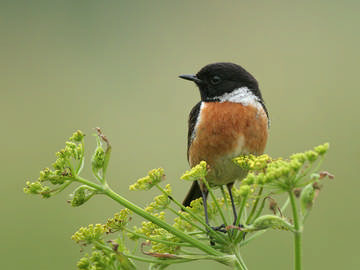
Stonechat © Steve Round
Stonechats have undergone a fascinating shift in distribution since our First Atlas: twenty years ago, this was a species breeding in the lowest-lying land in the county, mainly in the north Wirral and the Mersey valley. Now, there are far fewer on the coast and others breeding at the highest altitudes in the eastern hills. As an insectivorous resident, this species is susceptible to hard weather and it is tempting to think that warmer winters have allowed them to flourish.
Since the end of fieldwork for our First Atlas in 1984, the annual county bird reports have several times lamented the loss of Stonechat as a breeding species, and there are only six records in the 19 years to the start of this Atlas in 2004, one each in 1986, 1990, 1992, 1995, 2002 and 2003. The record near Three Shires Head (SK06E) in 1995 was of special significance, although not noted as such in the bird report, as it appears to be the first recorded breeding in the hills since Coward and Oldham (1910) said that it ‘nests in the hill-country in the east but is not abundant’. Neither Boyd (1946) nor Bell (1962), in their writings on the county’s birds, made any comment on its status in the hills. Another pair bred ‘in the east of the county’ in 2002, then the start of this Atlas in 2004 coincided with a resurgence in records.
It is impossible to know to what extent the increase in fieldwork for this survey yielded more records, but upland breeding was well established in Cumbria and Lancashire long before it was reported in Cheshire. In Lancashire, the tetrad Atlas in 1997-2000 found over 40 pairs in the uplands of Bowland and the west Pennines. In Cumbria, atlas fieldwork spanning 1997-2001 estimated a total of 1,000 pairs, mostly along the coast but with several hundred in the Lake District hills up to an altitude of 500 m.
Stonechats will breed in a wide variety of habitats, probably the only common characteristic being ‘rough’ ground, avoiding woodland and most areas in agricultural use. They need scattered bushes, trees, fence-posts or wires for use as song-posts and for perching whilst watching for their insect prey. Their catholic taste was borne out in this survey when the 28 occupied tetrads yielded as many as 18 different habitat codes. The most frequent were C5 (dry grassland – 6 records), B7 (scrub – 6 records) and E2 (unimproved grassland – 5 records), with no other code being registered more than twice.
Stonechats start to breed early in the year, with eggs often laid in late March in lowland sites, although later at higher altitude. They nest from ground level up to about 1 m, usually at an arm’s length deep inside gorse or other dense bush. Most pairs have two broods, and three is not unusual, extending the season into August. With an average of 5 chicks each time, this high reproductive potential allows them to balance the losses in cold weather, or alternatively allows rapid population growth when overwinter survival is higher.
This is a conspicuous bird, perching prominently and having a loud alarm call, a typically chat-like ‘tack tack’, albeit with a weak song. Adults with food in their bills, especially when feeding recently-fledged broods, are easy to see. The breeding status codes reflect this, with one record of a nest with young, two of adults carrying food for their young and ten tetrads where observers saw recently fledged young.
As well as the shift in the distribution to the eastern hills, the birds in Delamere represent a return to an area where Oldham found a brood in 1904, in 1927 it was said to be nesting regularly (Bell 1962) and Boyd (1951) found them breeding in the 1930s.
There were 13 tetrads with proven breeding at some stage during this Atlas survey. The national population index (dating only from 1994) roughly doubled from 1994 to 2004 and Cheshire and Wirral have shared in this growth. The number of breeding pairs in the county is probably just into double-figures, its highest recorded level since 1978.
Sponsored by Irene Blagden

